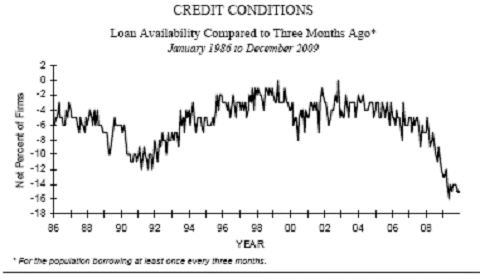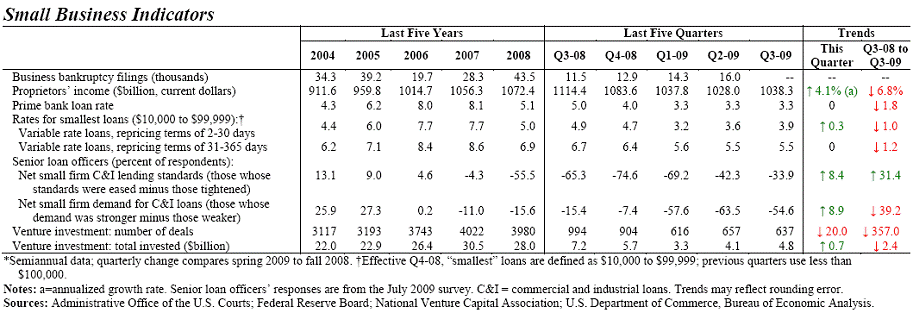Casey Mulligan titles a post Credit Study by the Federal Reserve Says No Crunch, citing a Macroblog post. But he neglects to mention that the survey is “A small business snapshot from the Southeast”. In contrast, a nation-wide NFIB survey summarizes conditions thusly:

Figure from NFIB Small Business Economic Trends (January 2010).
From the report:
Regular borrowers (accessing capital markets at least once a quarter)
continued to report difficulties in arranging credit at the highest frequency
since 1983. A net 15 percent reported loans harder to get than in their last
attempt, unchanged from November. Still that is not nearly as severe as the
financial distress reported in the pre-1983 period. Twenty-four months of
recession have sapped the financial strength of many small firms.
Thirty-three (33) percent reported regular borrowing, fairly typical of post-
1983 and unchanged from November. Eight percent of all owners reported
that their borrowing needs were not satisfied, down two points from
November. The remaining 92 percent of all owners either obtained the
credit they wanted or were not interested in borrowing. Only 4 percent of
the owners reported “finance” as their #1 business problem (down 1 point).
Pre-1983, as many as 37 percent cited financing and interest rates as their
top problem. The percent of owners reporting higher interest rates on their
most recent loan was seven percent, while three percent reported lower
rates. The net percent of owners expecting credit conditions to ease in the
coming months was a seasonally adjusted net negative 15 percent (more
owners expect that it will be “harder” to arrange financing).
For those who have short memories, pre-1983 incorporates back-to-back recessions…
Two observations here:
- A relevant question one should ask is what are the credit conditions facing the firms that have already failed? Less facetiously expressed, we know the sample of surveyed firms (in both cases) is a censored one. We do not know how many firms disappeared out of the sample because of an inability to access credit.
- One interesting aspect of the survey is that some firms do not find credit a constraint now, but that is because demand is low. What happens when demand rises? Then presumably credit constraints (“supply”) becomes a binding constraint for more firms. Given that the drop in retail sales and consumption relative to trend have been breathtaking, the thought that credit constraints will become more binding for small firms going forward is, to say the least, plausible.
Ending note: Here are the statistics from the Small Business Administration Office of Advocacy Quarterly Statistics (November 2009):

Table from SBA, Quarterly Statistics 3rd Quarter 2009 (November 9, 2009).
For the trends for the last five quarters, lotta down red arrows where one wants to see up green arrows. And a green up arrow indicating tightening lending standards…
Thanks Menzie! I’ve never read the “SBA Quarterly Indicators” report before. It is refreshingly concise and contains an ecclectic wealth of information. It has my vote for some of the best Cliff Notes on commercial activity…
It is of course correct, that America must deleverage in order to get out of long-term economic decline. Commercial banks understand it. How about congress and their econo-cognoscenti?
May be of interest to compare NIFB Small business economic trend with
National Bureau
of Economic Research
BULLETIN 50
APRIL 18, 1934
A NON.PROFIT MEMBERSHiP CORPORATION FOR IMPARTIAL STUDiES IN ECONOMIC AND SOCIAL
BROADWAY, NEW YORK
Recent Corporate Profits in the United States
Copyright 1934, National Bureau of Economic Re.rcarch, Inc.
SOLOMON FABRICANT
Notes P 6- 7 TAB 5 of the report are showing the breakdown of profits and losses by size groups that is total assets. The results are consistent with the economic downturn cycles, the smaller the companies (as an aggregate) the harder the chock,when the largest companies were still reporting profits in 1931.
It could be of interest to compare the trend from 2007 1929 as index 100 and onwards (TAB6 P8)
Consideration could be given in using banks under FDIC administration as channeling distribution of a government agency fund for the purpose of discounting receivables ?
What is interesting t me is that the Fed survey, in fact, says there is a credit crunch. The basic results are that 1/2 of firms did not need credit but of the half that did, 60% obtained all or most of the credit they needed. That means that many firms were completely shut out and some that did get credit did not get as much as desired. For example 70% of construction firms got no financing and 50% of manufacturing firms got no financing. That sounds like a credit crunch to me. So Casey cannot say there is no crunch based on the survey.
Next, ask those small business owners whether a lack of credit is a constraint on their businesses.
The answer? No. It’s literally the *last* thing on their list.
http://www.asymptosis.com/the-sky-is-falling-business-lending-down-1-2-percent.html